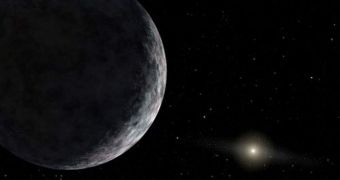A recent series of investigations has determined that the surface of the Kuiper Belt object Eris is similar in composition to that of the dwarf planet Pluto.
The announcement was made on Wednesday, October 5, at the42nd meeting of the American Astronomical Society's Division for Planetary Sciences, which was held in Pasadena, California.
These new information could be of great value for astronomers seeking to understand how the outer fringes of the solar system developed over the past 4.5 billion years.
Both dwarf planets apparently have a frozen surface, which is almost entirely made up of nitrogen ice. They look very much the same despite of being separate by a large distance, and having different sizes.
“By measuring and then comparing and contrasting the properties of Eris and Pluto, we can better understand how planets in the outer solar system formed and then evolved over the last 4.5 billion years,” explained William Grundy.
He was a researcher on the new study, and is an astronomer at the Lowell Observatory, in Flagstaff, Arizona. Details of the new work have been submitted for publication in an upcoming issue of the esteemed Astrophysical Journal.
As a side note, not many people know that Eris was one of the main reasons why Pluto was stripped of its classification as a planet, and demoted to dwarf planet.
Despite orbiting the Sun farther away then Pluto, Eris is 27 percent more massive, and has a diameter of 1,600 miles (2,581 kilometers). The other space rock is just 1,430 miles (2,306 kilometers) across.
Both space bodies have average surface temperatures of about minus 390 degrees Fahrenheit (minus 234 degrees Celsius), and experts decided to model them in a vacuum test chamber.
They placed ice samples of methane, nitrogen, argon, methane-nitrogen mixtures and methane-argon mixtures inside the chamber, at the North Arizona University, and then watched the crystals grow.
Using a spectrograph, the researchers looked at the chemical fingerprints that light reflected from this mixture produced. The data was compared to telescope readings collected off the surface of Pluto and Eris.
“By combining the astronomical data and laboratory data, we found about 90 percent of Eris' icy surface is made up of nitrogen ice and about 10 percent is made up of methane ice, which is not all that different from Pluto,” scientist David Cornelison adds.
The expert holds an appointment as an astronomer at the Missouri State University. “By studying surfaces of icy dwarf planets, we hope to get a better understanding of the processes that affect their surfaces,” adds Stephen Tegler.
He is based at the Northern Arizona University, and was the lead researcher on the new work, Space reports.

 14 DAY TRIAL //
14 DAY TRIAL //